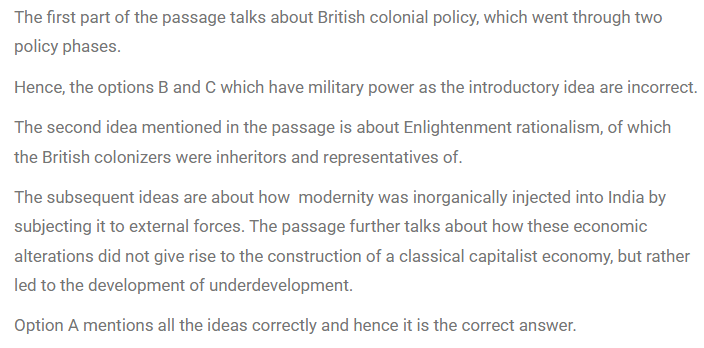CAT RC Questions | CAT RC Based on Humanities questions
FundaMakers is the Best CAT Online Coaching In India. Now prepare for CAT anytime with FundaMakers. We provide well-ordered syllabus coverage for both offline and online CAT preparation batches. FundaMakers brings to you the power-packed, well-structured CAT previous year question bank with more than 4000+ CAT Past Year questions. In the VARC section, one of the most frequently asked questions is from the topic- Reading Comprehension. Reading Comprehension turns out to be an important part of the VARC section from which over 60-70% of the questions are based on RC in the CAT Exam.
FundaMakers as a team has taken a painstaking step to bring you all the video solutions of the Reading Comprehension asked in the Previous Year CAT exam. CAT question bank offered by FundaMakers is a power-packed topic-wise compilation of the entire CAT previous year questions. Questions from the Reading Comprehension topic are some of the most scoring questions in the VARC section. To maximize your CAT score make use of FundaMakers CAT Question Bank. “Questions from CAT previous years” examination papers have been incorporated. Let’s get started with CAT Past Year Reading Comprehension Questions.
Comprehension
Directions for question: Read the passage carefully and answer the given questions accordingly
British colonial policy . . . went through two policy phases, or at least there were two strategies between which its policies actually oscillated, sometimes to its great advantage. At first, the new colonial apparatus exercised caution, and occupied India by a mix of military power and subtle diplomacy, the high ground in the middle of the circle of circles. This, however, pushed them into contradictions. For, whatever their sense of the strangeness of the country and the thinness of colonial presence, the British colonial state represented the great conquering discourse of Enlightenment rationalism, entering India precisely at the moment of its greatest unchecked arrogance. As inheritors and representatives of this discourse, which carried everything before it, this colonial state could hardly adopt for long such a self-denying attitude. It had restructured everything in Europe—the productive system, the political regimes, the moral and cognitive orders—and would do the same in India, particularly as some empirically inclined theorists of that generation considered the colonies a massive laboratory of utilitarian or other theoretical experiments. Consequently, the colonial state could not settle simply for eminence at the cost of its marginality; it began to take initiatives to introduce the logic of modernity into Indian society. But this modernity did not enter a passive society. Sometimes, its initiatives were resisted by pre-existing structural forms. At times, there was a more direct form of collective resistance. Therefore the map of continuity and discontinuity that this state left behind at the time of independence was rather complex and has to be traced with care.
Most significantly, of course, initiatives for . . . modernity came to assume an external character. The acceptance of modernity came to be connected, ineradicably, with subjection. This again points to two different problems, one theoretical, the other political. Theoretically, because modernity was externally introduced, it is explanatorily unhelpful to apply the logical format of the ‘transition process’ to this pattern of change. Such a logical format would be wrong on two counts. First, however subtly, it would imply that what was proposed to be built was something like European capitalism. (And, in any case, historians have forcefully argued that what it was to replace was not like feudalism, with or without modificatory adjectives.) But, more fundamentally, the logical structure of endogenous change does not apply here. Here transformation agendas attack as an external force. This externality is not something that can be casually mentioned and forgotten. It is inscribed on every move, every object, every proposal, every legislative act, each line of causality. It comes to be marked on the epoch itself. This repetitive emphasis on externality should not be seen as a nationalist initiative that is so well rehearsed in Indian social science. . . .
Quite apart from the externality of the entire historical proposal of modernity, some of its contents were remarkable. . . . Economic reforms, or rather alterations . . . did not foreshadow the construction of a classical capitalist economy, with its necessary emphasis on extractive and transport sectors. What happened was the creation of a degenerate version of capitalism—what early dependency theorists called the ‘development of underdevelopment’.
CAT/2019.2
Question . 82
Which one of the following 5-word sequences best captures the flow of the arguments in the passage?
Explanatory Answer
Method of solving this CAT RC Question from RC Based on Humanities question
Correct Option: A

Hey!
Worried about IIM calls due to your marks in 10th,12th, and Graduation?
Don't worry! Know your chances of getting an IIM Call based on your profile with our:-
Profile Professor: https://fundamakers.com/profile-professor/

5 Must- NOT-Dos during CAT Preparation.
- Do not treat CAT as 'Everything'.
- Do not quit your job for CAT exam preparation.
- Learning till The Eleventh hour instead of doing proper revision.
- Not checking the syllabus thoroughly.
- Piling up multiple books.
Click To Read:- Common mistakes made by CAT aspirants during preparation.
FundaMakers- Best Online and Offline CAT Online Preparation Institute in India
For any CAT Preparation related query, reach out to us at 9598333344.